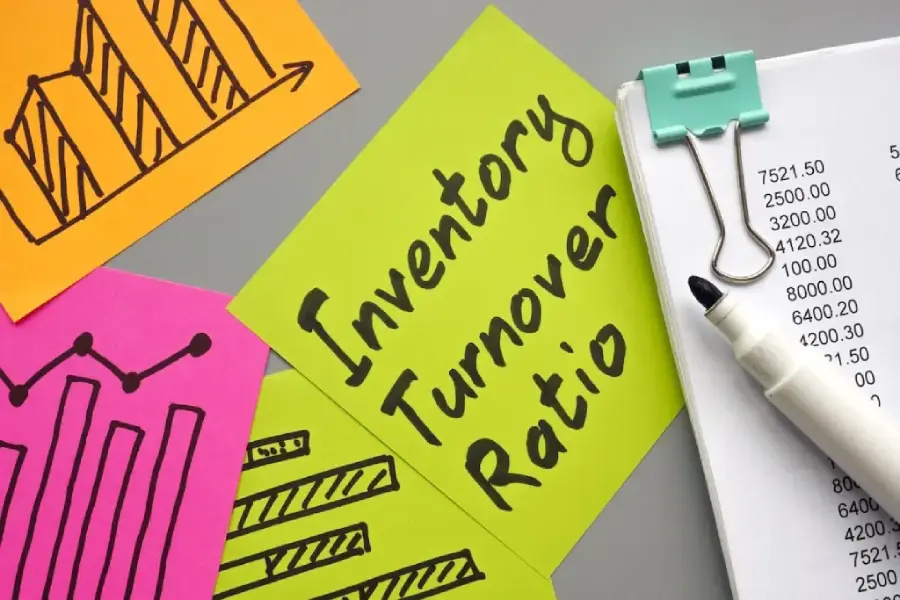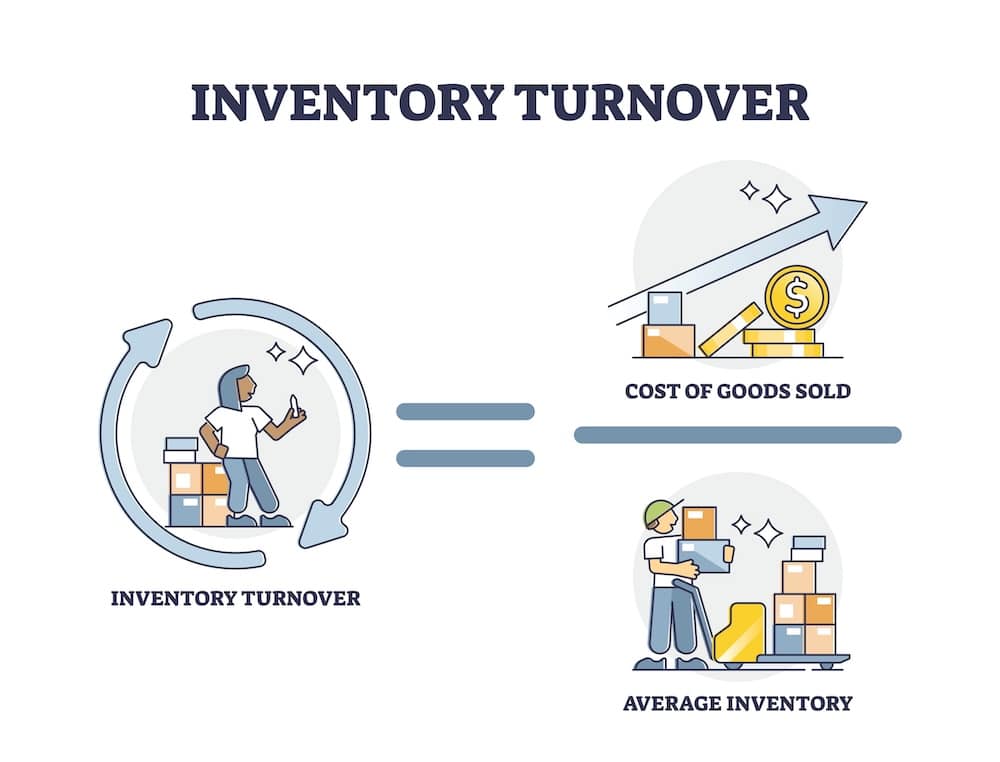
Mastering your inventory turnover ratio can transform your business by ensuring your shelves are stocked with the right products, cash flow is steady, and storage costs stay low. This blog post will guide you through the details of understanding, calculating, and improving your inventory turnover ratio—helping turn potential inventory challenges into opportunities for growth.
By the end of this guide, you’ll not only know how to calculate your inventory turnover ratio but also understand its importance, recognize industry benchmarks, and learn practical solutions to enhance your business performance. Whether you’re new to inventory management or looking to refine your strategies, this comprehensive guide has something for everyone.
Key Takeaways:
- Understand the Inventory Turnover Ratio: Learn to calculate and use this key metric to improve sales efficiency and inventory management.
- Boost Cash Flow: See how optimizing your turnover ratio can free up capital, reduce holding costs, and streamline decision-making.
- Set Industry Benchmarks: Discover the ideal turnover ratios for your sector and set realistic goals for performance.
- Take Action to Improve: Implement inventory management practices, adjust pricing, and enhance marketing to raise your inventory turnover ratio.
- Leverage Tools: Find out how inventory management software can automate tracking and provide timely insights for better performance.
What Is the Inventory Turnover Ratio?
The inventory turnover ratio measures how often a company sells and replaces its inventory over a certain period. It’s a key indicator of sales efficiency and inventory management, showing how well a business is optimizing its resources.
To calculate the inventory turnover ratio, you divide the cost of goods sold (COGS) by the average inventory value. This number represents the number of times inventory is sold and replaced, providing valuable insights into how efficiently a business is managing its supply chain and product demand.
A higher inventory turnover ratio reflects effective sales generation, resource optimization, and reduced holding costs—factors that are crucial for profitability. Businesses use this ratio to evaluate overall inventory performance and get a clear picture of cash flow and inventory management efficiency.
Tracking your inventory turnover ratio over time or comparing it with industry benchmarks can help identify market trends, understand customer purchasing behavior, and determine which products are moving quickly versus those that are underperforming.
Key insight: Successful companies often aim for multiple inventory turnovers per year, which indicates strong sales performance and efficient inventory management practices.
Why Inventory Turnover Ratio Matters
The inventory turnover ratio is a critical metric for assessing how efficiently your business manages inventory and cash flow. If too much capital is tied up in excess inventory, it becomes harder to recover funds, leading to cash flow problems. Poor turnover management can also inflate storage costs and hinder growth.
On the flip side, by maintaining the right inventory volumes based on demand, you can reduce waste and improve profitability. Calculating and optimizing your turnover ratio allows you to better align your pricing, marketing, and purchasing strategies with real market demand.
Calculating Inventory Turnover Ratio

To calculate the inventory turnover ratio, you’ll need financial data from both the income statement and the balance sheet. The formula requires dividing the cost of goods sold (COGS) by the average inventory value. This straightforward calculation shows how frequently inventory is sold or replaced within a specific period.
Here’s how it works:
- COGS ÷ Average Inventory Value = Inventory Turnover Ratio
To get the average inventory value, add the beginning and ending inventory values for a period, then divide by two. This helps account for fluctuations in inventory levels over time, giving you a more accurate measure of inventory turnover.
By understanding this ratio, businesses gain insights into how efficiently they are managing inventory, which is essential for making informed decisions on restocking and optimizing operations.
Accurate calculation of the inventory turnover ratio is crucial for fine-tuning your inventory levels and improving overall efficiency.
How to Analyze Your Inventory Turnover Ratio
Once you’ve calculated your inventory turnover ratio, the next step is to analyze what it reveals about your business. This ratio offers insights into cost management, sales performance, and how well your logistics are functioning.
A healthy inventory turnover ratio typically falls between 5 and 10, signaling a good balance between sales and restocking. This range indicates that you’re not overstocked, but also not running into stock shortages. By regularly analyzing your ratio, you can identify which products are selling quickly and which might need adjustments in pricing or marketing.
A high inventory turnover ratio generally points to strong sales and effective inventory management, but if it’s too high, it could lead to stock shortages and missed sales opportunities. On the other hand, a low inventory turnover ratio might indicate weak sales, overstocking, or inefficient inventory management, all of which can impact cash flow and profitability.
Analyzing your inventory turnover ratio over time, or against competitors, helps you spot areas for improvement and make strategic decisions to optimize your inventory levels, sales strategies, and supply chain performance.
Ideal Inventory Turnover Ratios by Industry
The optimal inventory turnover ratio varies by industry, typically ranging from 2 to 4 for most retailers. For high-volume, low-margin industries, turnover ratios tend to be higher compared to low-volume, high-margin sectors. Understanding these industry-specific benchmarks is crucial for setting realistic goals and measuring performance accurately.
For example:
- Car dealerships typically have an average turnover ratio of 3.
- Jewelers often see turnover ratios between 1 and 2.
- Grocery stores, on the other hand, boast an impressive annual turnover ratio of over 15.
These examples highlight the diversity of inventory turnover ratios across different sectors, illustrating how the context of each industry is important when evaluating performance. Setting industry-specific goals will give you a clearer picture of how well your inventory management practices measure up.

Low Inventory Turnover Ratio
A low inventory turnover ratio can signal overstocking or poor sales performance, both of which have significant financial consequences. When too much inventory is sitting in storage, it ties up capital and resources, making it harder to maintain healthy cash flow and operational efficiency.
This often happens when market demand is weaker than expected or when businesses overestimate how much inventory they need. For example, if a company holds 100 units of a product but only sells 20 over a certain period, it’s a clear sign that resources are being tied up in unsold stock.
Low turnover can also indicate outdated inventory or poor inventory management practices. Addressing this issue requires rethinking your inventory strategy. Start by assessing product demand, adjusting order volumes, and improving marketing efforts to move excess stock.
High Inventory Turnover Ratio
A high inventory turnover ratio indicates that products are moving quickly, which is typically a good sign of strong sales performance. However, it can also be a double-edged sword. If the ratio is too high, it might lead to stock shortages, making it difficult to meet customer demand—especially during peak periods.
While rapid inventory turnover generally reflects efficient sales and inventory management, an excessively high ratio could indicate that you’re not keeping enough stock on hand, leading to missed sales opportunities. Over time, this could hurt customer satisfaction if they can’t get the products they want when they need them.
The goal is to find a balanced turnover ratio—one that keeps inventory levels high enough to meet demand, but not so high that you’re risking stockouts and lost revenue.
Improving Inventory Turnover Ratio
Improving your inventory turnover ratio involves a combination of better inventory management, pricing strategies, and sales optimization. Here are some effective strategies:
- Refine your inventory management: Implement systems like Just-In-Time (JIT) inventory to reduce the amount of stock you keep on hand, which can help improve turnover rates. This method ensures that products arrive just in time to meet demand without overstocking.
- Analyze sales data: Look closely at which products are selling quickly and which ones are lagging behind. Adjust order quantities accordingly to optimize cash flow and avoid holding onto slow-moving stock.
- Adjust pricing strategies: Competitive, dynamic pricing can help move slow-selling inventory, while discounting or bundling products can clear excess stock, boosting turnover.
- Strengthen supplier relationships: Work with suppliers to negotiate better terms, including more frequent deliveries in smaller quantities, so you can maintain a steady flow of inventory without overloading your warehouse.
By implementing these strategies, businesses can enhance their inventory turnover ratio, improving cash flow, reducing storage costs, and maximizing overall profitability.
Optimize Inventory Management
Effective inventory management is essential for maintaining a healthy inventory turnover ratio. A Just-in-Time (JIT) inventory system is one way to improve turnover by ensuring that stock arrives only when it’s needed to fulfill customer orders, reducing excess inventory on hand. This system minimizes storage costs and maximizes cash flow by avoiding overstocking.
Automation can also play a significant role in optimizing your inventory. Using inventory management software to automate reordering processes and track stock levels in real time helps reduce manual errors and ensure you’re never caught with too much or too little inventory.
An open-to-buy system, which helps businesses budget for purchases and maintain appropriate inventory levels, can further streamline purchasing decisions. This system ensures you’re making data-driven decisions to keep stock levels balanced, improving overall turnover.
A well-optimized supply chain not only lowers inventory holding costs but also ensures you’re able to meet customer demand without overstocking.

Adjust Pricing Strategies
Pricing is a powerful lever for influencing inventory turnover. Implementing dynamic pricing models allows you to adjust prices based on real-time market conditions, helping you move products more quickly.
For example, if demand for a particular product is lagging, offering a temporary discount or promotional bundle can encourage sales and clear out excess stock. On the other hand, if demand is high, you can increase prices slightly to maximize profitability without sacrificing too many sales.
A successful case study illustrates this: A business that adjusted its pricing strategies based on customer demand was able to significantly improve its inventory turnover. By aligning product value with customer expectations, they cleared out underperforming inventory while maintaining strong margins.
Strategic pricing is an essential tool for optimizing your inventory turnover ratio and keeping stock levels healthy.
Enhance Marketing Efforts
Marketing plays a vital role in inventory turnover. Promotions and targeted campaigns can drive demand for specific products, especially slow-moving items. Offering discounts, bundles, or limited-time offers can quickly increase sales and clear excess stock.
Improving your overall customer experience can also boost inventory turnover. For example, offering detailed product descriptions, pre-order options, and clear return policies can encourage more confident purchasing decisions, minimizing returns and ensuring a smoother sales flow.
By enhancing your marketing efforts, you not only boost sales but also stabilize inventory flow. Promotions and strategic marketing campaigns allow you to move products more efficiently, helping maintain a balanced turnover ratio.
Common Challenges with Inventory Turnover Ratio
While the inventory turnover ratio is a valuable tool, certain challenges can affect its accuracy and usefulness. For instance, poor inventory management practices, over-purchasing, or inadequate sales strategies can lead to inaccurate turnover ratios. External factors such as economic downturns or unexpected supply chain disruptions can also negatively impact turnover, making it harder to interpret the data accurately.
Another common issue is failing to track product performance closely. If slow-moving items aren’t identified and dropped from your catalog, they can drag down your turnover ratio. Businesses need to consistently evaluate product profitability and make adjustments to keep turnover ratios healthy.
A real-life example shows how optimizing the supply chain helped a business reduce lead times and increase manufacturing output, leading to improved inventory turnover. This case highlights the importance of strategic adjustments in overcoming turnover challenges.
Seasonal Variations
Seasonal demand plays a significant role in inventory turnover, causing fluctuations in sales at different times of the year. For example, inventory turnover may slow down during the lead-up to peak seasonal periods, only to surge during the actual season. This makes planning for seasonality a crucial part of inventory management.
Businesses should adjust inventory levels based on these fluctuations. For example, increasing stock ahead of holidays or peak seasons can ensure that you meet demand without running into stock shortages. On the other hand, reducing stock during off-peak times helps avoid tying up capital in products that won’t sell quickly.
A good practice for managing seasonal items is to temporarily remove them from working inventory during the off-season, which helps maintain a more accurate turnover ratio. For example, flower shops often increase their stock for Valentine’s Day, but drastically reduce it afterward.
Understanding and planning for these seasonal variations is key to maintaining a stable and predictable inventory turnover ratio year-round.

Data Accuracy
Accurate data is the backbone of effective inventory management and is crucial for calculating the inventory turnover ratio. Inaccurate or incomplete data can skew turnover calculations, leading to poor inventory decisions and financial missteps.
Regularly updating your inventory records, tracking real-time stock levels, and using automated inventory management systems are key to maintaining data accuracy. This ensures you can make informed decisions based on reliable numbers.
Maintaining accurate inventory data not only helps with turnover calculations but also supports better forecasting, order management, and overall business performance.
Overstocking and Understocking
Both overstocking and understocking can have serious consequences for your inventory turnover ratio. Overstocking occurs when a business orders more inventory than it can sell, leading to excess stock that ties up capital and increases storage costs. Not only does this hurt cash flow, but it can also result in outdated or obsolete inventory.
On the flip side, understocking happens when a business doesn’t order enough inventory to meet customer demand. This can lead to stockouts, where products are unavailable during periods of high demand. Stockouts mean missed sales opportunities, frustrated customers, and potential damage to your brand’s reputation.
To avoid these pitfalls, businesses should regularly review their inventory levels and adjust them according to demand forecasts. Implementing tools like automated reordering systems and conducting frequent inventory audits can help strike the right balance between overstocking and understocking, ensuring that you maintain a healthy inventory turnover ratio.
Tools and Software for Managing Inventory Turnover
Utilizing inventory management software can significantly improve your ability to track and optimize inventory turnover. These tools automate the tracking of stock levels, provide insights into turnover rates, and help forecast demand, all of which can enhance operational efficiency.
For example, inventory management software can:
- Provide real-time data on stock levels, helping you avoid overstocking or understocking.
- Automatically generate purchase orders when inventory falls below a set threshold, ensuring you always have the right products available.
- Track sales patterns and generate reports, allowing you to make data-driven decisions about which products to restock or discontinue.
Investing in the right software helps improve data accuracy and provides automatic notifications for replenishing items, ensuring your business stays ahead of demand while minimizing holding costs. With better tools in place, businesses can maintain optimal inventory levels and achieve a higher inventory turnover ratio.
Argos Software: Your Trusted Partner for Optimizing Inventory Turnover
Improving your inventory turnover ratio requires both strategic insight and the right tools, and Argos Software offers powerful solutions to help you achieve this balance. Our comprehensive inventory management software is designed to streamline your operations, giving you real-time insights and automated processes to optimize stock levels, reduce costs, and boost profitability.
With Argos, you can:
- Automate Reordering: Set thresholds for automatic restocking to ensure you never overstock or run out of essential items.
- Gain Real-Time Inventory Visibility: Monitor stock levels, sales performance, and turnover metrics instantly with easy-to-use dashboards.
- Leverage Forecasting Tools: Use historical data and advanced analytics to predict demand and adjust your inventory levels for seasonal changes or market trends.
- Improve Cash Flow: By optimizing your turnover ratio, Argos Software helps free up capital tied in excess stock, allowing you to reinvest in growth opportunities.
With Argos Software, businesses can transform their inventory management processes into a competitive advantage—ensuring you always have the right products at the right time. Let us help you master your inventory turnover and unlock your company’s full potential.
Summary
Mastering your inventory turnover ratio is essential for enhancing business performance, optimizing cash flow, and reducing holding costs. By understanding how to calculate, analyze, and improve your turnover ratio, you can make more informed decisions about inventory management and ensure your business operates efficiently.
Implementing effective inventory management practices, adjusting pricing strategies, and boosting marketing efforts are key to achieving a healthy turnover ratio. Additionally, leveraging inventory management software can streamline processes, enhance data accuracy, and provide real-time insights to help you make smarter decisions.
Embrace these strategies and insights to optimize your inventory turnover, improve profitability, and position your business for long-term success.
Ready to take control of your inventory and boost profitability? Contact Argos Software today to learn how our powerful inventory management solutions can help you optimize your turnover ratio and drive business success!
Frequently Asked Questions (FAQ)
1. What is the inventory turnover ratio?
The inventory turnover ratio measures how many times a company sells and replaces its inventory over a specific period. It’s a key metric used to evaluate how efficiently a business is managing its stock and optimizing resources.
2. How do you calculate the inventory turnover ratio?
To calculate the inventory turnover ratio, divide the cost of goods sold (COGS) by the average inventory value. The formula looks like this:
- Inventory Turnover Ratio = COGS ÷ Average Inventory
This calculation shows how many times your inventory is sold and replaced in a given period.
3. What is considered a good inventory turnover ratio?
A good inventory turnover ratio typically falls between 5 and 10, depending on the industry. A higher ratio usually indicates efficient inventory management, but it’s important to avoid stock shortages. The optimal ratio will vary based on factors like industry, product type, and business model.
4. What are the risks of a low inventory turnover ratio?
A low inventory turnover ratio often indicates overstocking or poor sales performance. It means capital is tied up in unsold stock, leading to higher storage costs and reduced cash flow. Businesses with low turnover may need to adjust pricing, marketing, or inventory levels to avoid financial strain.
5. What are the risks of a high inventory turnover ratio?
While a high turnover ratio can signal strong sales, it may also indicate that inventory levels are too low. This can result in stockouts, missed sales opportunities, and potential customer dissatisfaction. Balancing inventory levels is key to avoiding these risks.
6. How can I improve my inventory turnover ratio?
You can improve your inventory turnover ratio by implementing better inventory management practices, such as Just-in-Time (JIT) inventory, adjusting pricing strategies, and running targeted marketing campaigns. Using inventory management software can also help track stock levels, automate reordering, and forecast demand more accurately.
7. Why is inventory turnover ratio important?
The inventory turnover ratio is important because it gives you a clear picture of how efficiently your business is managing its stock. It directly impacts your cash flow, holding costs, and profitability. Understanding this ratio allows you to make better decisions about pricing, purchasing, and stock levels.
8. How does inventory turnover differ by industry?
Inventory turnover varies significantly by industry. For example, high-volume, low-margin industries like grocery stores may have turnover ratios above 15, while lower-volume, high-margin industries, such as jewelry, often see ratios between 1 and 2. It’s essential to benchmark your turnover ratio against industry standards to evaluate your performance effectively.
9. What tools can help manage inventory turnover?
Inventory management software is a powerful tool for managing turnover. It provides real-time data on stock levels, automates reordering, and helps forecast demand, ensuring you maintain optimal inventory levels and avoid overstocking or understocking.
10. How does seasonality affect inventory turnover?
Seasonal demand can cause fluctuations in inventory turnover. Sales may slow down during off-peak times and surge during peak seasons. Planning for seasonality by adjusting inventory levels ahead of these fluctuations is key to maintaining a stable turnover ratio.




